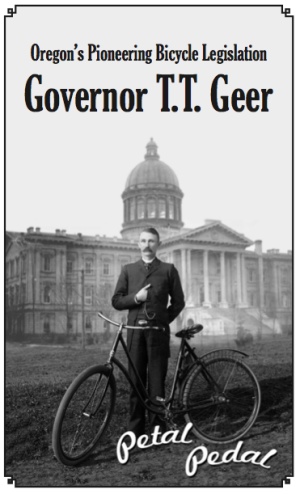“… it being the object and intent of this act to provide for pedestrians and bicycles a highway separate from that used by teams and horsemen.”— Excerpt from House Bill 63
The more I read about Oregon’s tenth governor, T.T. Geer, the more intriguing this man becomes.
As we shared back in 2009, Governor Geer was the man who put bicycling on the map in Oregon at the turn of the 20th century. He served as governor from 1899 through 1903 — right in the midst of what many consider the golden age of bicycling in America. Today I came across an email from reader Larry H. that included a PDF of a piece of legislation Geer pushed through in 1901 known as House Bill 63; also known as, “Oregon’s Bicycle Path Bill.”
I knew Geer was bike-oriented, but never realized just how broad his bike policies were until I read the text of HB 63 this morning. I found it fascinating. Many of the provisions included in the bill — a tax on bicycle riders, ongoing revenue for infrastructure, and so on — are things we are still debating 111 years later.
HB 63, which was approved by the Oregon Legislature on February 25, 1901, was an effort by Geer to do two major things: provide ongoing funding for building physically separated bike/walkways and to define the term “bicycle”.
The most important provision gave counties the authority to, “build, repair, and maintain paths on either or both sides of all public highways… for the use of pedestrians and bicycles.” And to pay for these new paths, the bill gave counties the option to levy a “license tax” of $1.00, “to be paid by any and all persons riding a bicycle.” One interesting stipulation is that Geer’s legislation allowed the “license tax” to be levied only after the new paths had been built (or promised to be built).

The bill stated that the tax was to be paid by, “any and all persons riding a bicycle in such counties as have exercised the authority above described on said paths as hereinafter provided.” The bicycle license tax fund would then be used to build and maintain the paths.
Not only did his bill call for a tax, but the courts were mandated to “provide a suitable tag” as a receipt that the fee had been paid. The tag needed to be purchased annually and had to be “properly and securely fastened on the seat post of each and every bicycle.” If someone was caught without a tag, the sheriff could seize and sell the bike. Here’s the actual text:
“… sheriff shall have power and authority to seize and sell as upon execution any bicycle for the amount of said license tax, together with costs and expenses of such seizure and sale, or may collect the same out of any property of said delinquent in the same manner as other delinquent taxes are collected.”
Geer also included language as to how the paths should be constructed. He clearly foresaw them as physically separated paths, much like the cycle-tracks we build today. “All such paths shall be constructed in such a manner that they will not interfere with any road, street, or crossing,” reads the bill:
“These paths when so constructed shall be for the use of pedestrians and bicycles, it being the object and intent of this act to provide for pedestrians and bicycles a highway separate from that used by teams and horsemen.”
The bill also sought to protect the paths and its users. Geer made it a misdemeanor to “injure or deface said paths” or to “place tacks, glass, wire, iron, sticks, stones, or any other substance upon said paths whereby the safety of the paths is imperiled or injury to the bicycle or any part thereof, or to the rider, or the pedestrian, result or is liable to result.” There was an exception for livestock, “providing the loose stock is not wantonly driven upon said paths and due care is taken to prevent injury to said paths.”
Punishment for violating this provision would result in a fine of no less than $10.00 or five days imprisonment, or both (“in the discretion of the court”).
This landmark bill also legally defined bicycles in Oregon:
“Bicycles,” as used in this act, shall be deemed to include bicycles, tandems, quads, etc. A “bicycle” is a vehicle propelled by a rider by foot power.”
(Today, the definition of “bicycle” (ORS 801.150) does not include “quads”, but it similar in other respects.)
And, just for good measure, the ninth and final section of House Bill 63 made it Oregon law that bicycles must have bells and lights. The light provision didn’t specify front or rear (like it does now), only that the bike is visible “at night with sufficient light to be easily distinguishable.” Punishment for not having a bell or lights could include a minimum $5 fine, three days in jail, or both.
I sure would have liked to meet Governor Geer. If you want to learn more, stop by the GeerCrest Farm & Historical Society just east of Salem, browse our “history” story tag, or grab a copy of the Oregon History Comics (which includes an excellent book on bike history).

